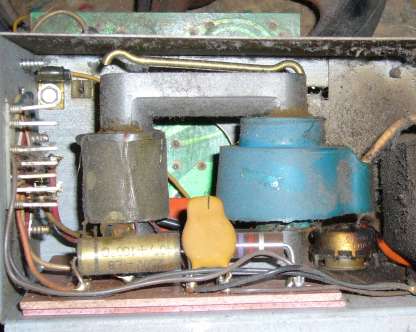Similar to the two transistor solid state Tesla Coil
already on this site, this solid state Tesla Coil design uses a normal
flyback transformer to generate it's high voltage output. Unlike the
other circuit, this one does not use two huge power transistors and high
wattage resistors. Instead it uses a 555 timer to more efficiently
drive a single MOSFET. It's waveform has adjustable off and on time,
making for an efficient circuit with little waste heat. It can be
adjusted to drive most commonly found flyback transformers and can
operate from a 12V to 18V supply. HV output can reach 60KV or more
depending on the transformer and supply voltage.
 |
Schematic |
Parts
| R1, R5, R9 | 3 | 180 Ohm 1/4W Resistor | |
| R2 | 1 | 10K Pot | |
| R3, R7 | 2 | 10 Ohm 1/4W Resistor | |
| R4 | 1 | 5K Pot | |
| R6 | 1 | 7.5K 1/4W Resistor | |
| R8 | 1 | 150 Ohm 1/4W Resistor | |
| R10 | 1 | 1 Ohm 5W Resistor | |
| C1 | 1 | 0.0047uF 50V Polyester Capacitor | |
| C2 | 1 | 0.05uF 50V Polyester Capacitor | |
| C3 | 1 | 220uF 25V Electrolytic Capacitor | |
| C4 | 1 | 0.01uF 1200V Polyester Capacitor | |
| Q1, Q2 | 2 | 2N2222 NPN Transistor | 2N3904 |
| Q3 | 1 | SSM5N55 MOSFET | |
| U1 | 1 | 555 Timer Integrated Circuit | |
| U2 | 1 | LM7809 9V Linear Regulator | |
| L1 | 1 | 100uH Choke Coil | |
| T1 | 1 | Penn-Tran 1-017-5372 Flyback Transformer | See Notes |
| MISC | 1 | Board, Wire, Case, Socket for U1, Heatsink For Q3, Output Terminal (See Notes) | |
Notes
- T1 as specified in the parts list is going to be almost impossible
to find, but don't worry. Penn-Tran was bought by Wiltron and no longer
exists. However, most any medium to large flyback transformer will work
as long as it does not have an internal rectifier. Suitable units are
most often found in TVs made during the 1970s and 1980s. Look for the
most impressive, dangerous, menacing transformer you can find. If you
need an idea, a picture of a great transformer for use in this circuit:
These can be found in a small metal box generally in the corner of the TV case, complete with a very handy voltage multiplier unit and usually a nice heatsink.

You will need to either look up the datasheet for the transformer you have, or probe it with an ohmmeter to identify the coil connections. Most flybacks have a load of taps on the HV side to provide focusing, horizontal and vertical signals. These taps are generally of no use to you. To find the primary (coil B-A on the schematic) you need to find the two lowest resistance connections that are not also connected to the HV secondary wiring. Alternately, if your flyback has an open frame like the one in the picture, you can wind on 5 or so turns of 16 gauge magnet wire as a primary. You will need to experiment with the number of turns to get maximum output. The HV ground lead (connection C on the schematic) is generally easy to locate. It will come from the HV secondary and be tied to the frame of the transformer or chassis ground.
If by some miracle you were able to locate the Penn-Tran transformer, then connection B is the red dot on the transformer, A corresponds to the black dot, and C matches the orange dot. - If the TV you salvaged the transformer from has a voltage multiplier unit (visible slightly at the far right of the above picture), then take it as well. It can multiply the output of this circuit into very high (over 100KV) DC voltages.
- When building the circuit, leave the flyback disconnected. Connect a 10 Ohm 10W resistor in place of the primary of T1 and connect a scope to the collector of Q3. Adjust R4 to produce an off time of about 10 microseconds. Adjust R2 for an on time of about 70 microseconds. Now remove the scope, 10 ohm resistor, and connect up T1. Power the circuit back on and you should have a high voltage available at the output. If you do not have a scope, just set both pots in their middle position and then adjust them by trail and error until you get the biggest spark at the output of T1.
- Q3 will require a heatsink.
- Needless to say, this circuit can produce dangerous voltage. At the very least you are looking at a painful shock. More then likely a decent burn will result from contact with the HV output, as well as instant and uncontrollable muscle contraction. If you have heart problems, don't build this circuit. Be careful!.


No comments:
Post a Comment